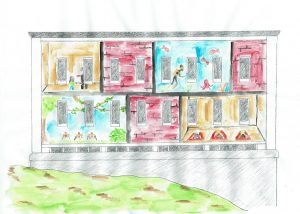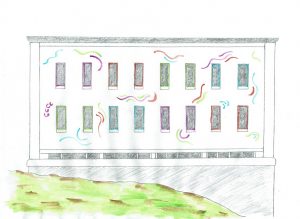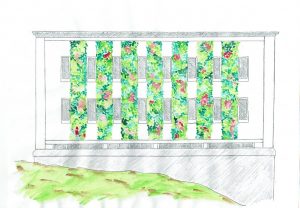Our project’s objective was to figure out a way to incorporate a form of art on the wall of Acopian facing Markle Admissions Building. The three alternate solutions: the mural, light installation, or vertical garden that we propose are very different solutions to the same problem, which is the rigidity and exclusivity surrounding the engineering culture at Lafayette College. However, we believe that each of the designs can help work towards changing this to create a more interdisciplinary and inclusive field. Each of these design ideas surfaced from either extensive research from other case studies, student surveys, and student/professor panels. In addition, we analyzed the social context, political context, economic context, and technical context surrounding this topic to make each solution specific to the needs of Lafayette. Laid out in the rest of the conclusion are the pros and cons of each of these designs and what needs to be done next to turn this project proposal into a reality. However, we believe that despite their cons, each design solution will provide some of the benefits laid out in the three subsections of our economic context and our social context: educational, psychological, and cultural. Luckily, all three of our design solutions are not mutually exclusive. This means that there can also be a combination of any of these solutions as the final product if this projects gets picked up by someone.
Mural
There are benefits with the implementation of an art mural on the facade of Acopian. First, the multiple images displayed on the exterior will reach various communities on the Lafayette campus. Our group wants the mural to resonate with many members attending or visiting the college and dedicating sets of panels to display several groups of images allows the necessary flexibility to ensure different communities are represented. Gaining input from sources and continuing student panels will be valuable knowledge for the future implementation of the project. Another positive aspect of this alternative is the ability to change the panels in the future. The college will not have to worry about the relevance of the images presented on the exterior of Acopian because panels allow switching and storage of previous images. This also presents an opportunity for the Lafayette community to be more involved in the design process of the next illustration and promote an interdisciplinary environment of Acopian. Applications from all disciplines offered at Lafayette could submit proposals detailing a representation of an image reflecting the interests of their respective majors. Trying to display many areas of campus in the mural is a positive start to promote an interdisciplinary environment. There are also some negative consequences applying the mural to Acopian. The intended message to promote collaboration and inclusiveness of Acopian might not reach all members of the community. Our group understands there are two perspectives we have to consider. There are students who use Acopian every day for their studies and there are students who have not stepped foot into Acopian once in the Lafayette career. We want “insiders” to learn more effectively and “outsiders” to feel more welcomed inside of the building. A mural might not be powerful enough to display the message and fuel the interest of an interdisciplinary environment among the surrounding members of campus. This alternative would also only be a first step towards other initiatives promoting a more welcoming environment. The exterior facade is just the gateway to the inside of Acopian. Trying to make students feel more welcomed inside the building will take more efforts in reconstructing or rearranging the inside of Acopian into a more collaborative and relaxing place. A mural can display these physical spaces or ideas, but to continue including more students into Acopian and ensuring a positive environment lasts an interior element of the project is missing from this alternative. Murals are a great alternative to publicly display a message and would begin the conversation surrounding a larger idea. However, the idea feels like just a start to the project of promoting a new culture inside Acopian.

Figure 28: Final mural concept design as created by Olivia Guarna (2018)
Light-based Art
A light sculpture has the benefit of visibility during the day and during the night by nature of it being neon lights. This has the added benefit of causing Acopian to stand out against the other buildings on campus. Acopian’s east wall is visible from the vast majority of the quad. This means that students walking along the quad during the evening will see a light installation on Acopian. Visibility is assured. Attracting students through the art introduces students from all majors to the building, creating a sort of “ice breaker” introducing the building. Additionally, the creation of this type of installation has great potential as a multi-discipline capstone project, independent study, or as a project in EGRS 480.
During our live presentation, factors were brought to our attention we had not considered when creating a light installation. Chief among questions was whether or not we had considered the light pollution effects and environmental repercussions from the glowing during evening hours. We did not analyze how the neon lighting would affect light pollution levels in and around the college. To better understand the effects of these factors, we would need better data on the size of the wall and the size of the windows. For the purposes of our preliminary investigation, we used an estimate based on the average size of a nearby bicycle compared to the building. This gave us ballpark measurements so that we could generate ballpark costs and material needs, but for quality data on light pollution we need to know the true size of the space.
If future students are to undertake this project, it is critical to begin with measurements of the eastern wall of Acopian, the windows, and the space between windows. The wall needs analysis for exterior and interior electrical systems the lights would access for power. The building’s exterior also needs study for purposes of the mounting brackets to ensure their safe and effective attachment to the outside surface. From there, participants need to settle on a design for the exterior space. This can be done within the team but we recommend conducting student, staff, and shareholder interviews for a better poll of opinions and desires.
At that point they can calculate material needs and costs. When looking at neon lighting tubes, it is important to understand how much rain/moisture the tubes will be exposed to. The team needs to find properly rated tubes for outdoor usage. We recommend calling distributors to get definitive answers as language used on websites can be cumbersome and hard to understand. The team will need to acquire funding, most likely through shareholders. This amount of development should be achievable within the period of one semester. Before moving any further down the process, students should ensure measurements, costs, and material needs are correct and an avenue for funding is established.

Figure 29: Final light art concept design as created by Olivia Guarna (2018)
Vertical Garden
Finally, we summarize our vertical garden alternative. Again, this alternative has an interior and exterior component: a green wall on the wall facing Markle hall and a green wall with soft blue light in a relaxation room in an Acopian classroom or lounge. To complete this process, we would need to hire a contractor that specializes in installing vertical gardens. Based on our research, we believe Acopian is a good candidate for an exterior garden. We estimate that this alternative will cost below $100,000.
There are a couple of drawbacks to this design that the school would need to consider. Like all large scale projects, this alternative comes at a high initial cost. Additionally, it would require major maintenance approximately every three years to replant the planters, which might be labor intensive. As far as the interior wall, there is also the issue of space. Green walls themselves take up very little space. However, if we wanted to create the entire relaxation room, we would need the engineering department to either part with one of their classrooms, or agree to renovate one of the majors’ existing lounges. Space is a hot commodity in Acopian, so this could pose a challenge.
Still, we recommend this as a viable alternative. There will be costs associated with any project. We believe this alternative has enough mass appeal to find supportive funders. Maintenance will be required, but unlike most of the landscaping work that is done on Lafayette’s campus every year, this will not be an annual task. Finally, we believe the benefits of an indoor relaxation room would be well worth the disruption to Acopian’s current setup. The impact students would be immense. However, if the engineering department could not reallocate a space for it, a green wall can still be implemented in the lobby without taking up any space.

Figure 30: Final green wall concept design as created by Olivia Guarna (2018)
Moving Forward
Throughout the course of semester, our group’s research and interviewing led us to be able to propose three different solutions and an analysis on the pros and cons of each solution as previously stated. Since we have three solution proposals, there is still a lot to be done if one or more of these design solutions are actually going to be implemented and there are many people that can be involved in the installation of one or more of these design solutions. While presenting the findings of our capstone project, we were asked about the differing environmental aspects of three different designs. We responded with saying that the environment was something that we did not go into depth analyzing; therefore, we did not have the information available to give an accurate enough analysis of them. We believe that this is a lens that definitely needs to be considered before an actual installation occurs more despite our group not having enough time to do so. Not only will this be important for our environment but it could also help Lafayette reach their climate action plan of being carbon neutral if something such as a vertical garden is installed, for example. That is to say, each design definitely has their own effects on the environment.
In addition to analyzing an environmental context, we recommend that whoever takes over this project or something similar focus on conducting more research specially on Lafayette’s campus to see what specific design idea would be most effective. This includes what plants and their order on the wall, the actual pictures of the mural, the shapes or types of lights for the light installation, and what colors are most effective for all three. Also, since these designs are not mutually exclusive, the next group could possibly figure out a way to implement more than one of them. After that research and the group finds one solution, we recommend doing a better economic analysis which included contacting possible artists and figuring out labor and material costs to a greater and more accurate extent. Lastly, we recommend involving more stakeholders that are responsible for finding funding or actually hiring contractors to make sure that all of this is indeed feasible.
For a complete list of sources, click here.